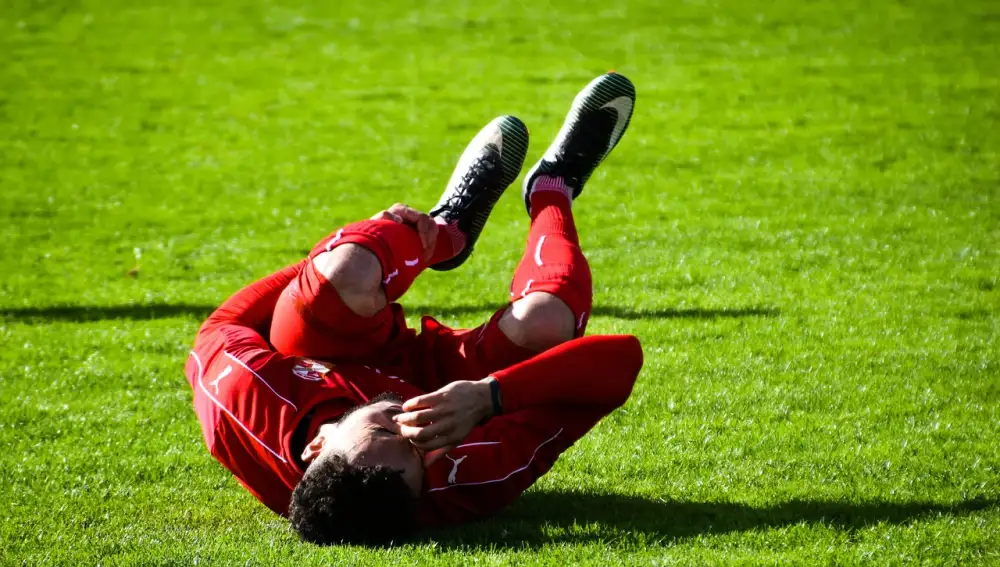Thumb Pain in Golf: Understanding and Managing the Ache for Optimal Performance

- - Briefly explain the concept of thumb pain in golf
- - Highlight the impact of thumb pain on a golfer's performance
- Causes of Thumb Pain in Golf
- - Overuse and repetitive motions
- - Incorrect grip technique
- - Poor swing mechanics
- - Pre-existing conditions or injuries
- Symptoms of Thumb Pain in Golf
- - Aching or throbbing pain in the thumb
- - Swelling or inflammation in the thumb joint
- - Difficulty gripping the club firmly
- - Limited range of motion in the thumb
- Prevention and Management of Thumb Pain
- - Warm-up exercises and stretches for the hands and fingers
- - Proper grip and swing technique
- - Using equipment with proper grip size and cushioning
- - Taking breaks and avoiding overuse
- - Applying ice or heat therapy to reduce inflammation
- - Seeking professional medical advice and treatment if necessary
- Rehabilitation and Recovery
- - Resting the thumb and avoiding activities that aggravate the pain
- - Physical therapy exercises to improve strength and flexibility
- - Gradually returning to golf activities after recovery
- - Using thumb braces or supports for added stability
- Tips for Golfers with Thumb Pain
- - Listening to the body and recognizing pain signals
- - Modifying the golf swing to reduce stress on the thumb
- - Using alternative grips or clubs if necessary
- - Incorporating regular hand and thumb exercises into a fitness routine
- - Emphasize the importance of addressing thumb pain in golf
- - Encourage golfers to prioritize their health and seek appropriate treatment
Thumb pain in golf is a common ailment that can significantly impact a golfer's performance on the course. The repetitive motions involved in swinging a golf club, combined with incorrect grip technique and poor swing mechanics, can lead to discomfort and pain in the thumb joint. This article aims to explore the causes, symptoms, prevention, and management of thumb pain in golf, as well as provide tips for golfers to alleviate their discomfort and optimize their performance. By understanding and addressing thumb pain, golfers can enjoy the game pain-free and achieve their full potential on the course.
- Briefly explain the concept of thumb pain in golf
Thumb pain in golf refers to the discomfort or ache experienced in the thumb joint and surrounding areas during or after playing golf. The repetitive motions involved in swinging a club, combined with incorrect grip technique and poor swing mechanics, can contribute to this condition. Thumb pain can significantly impact a golfer's performance, affecting their ability to grip the club firmly and execute precise shots. Understanding the causes, symptoms, and management techniques for thumb pain is crucial for optimal performance on the golf course.
- Highlight the impact of thumb pain on a golfer's performance
Thumb pain can have a significant impact on a golfer's performance. The thumb plays a crucial role in gripping and controlling the club, making it essential for generating power and accuracy in shots. When experiencing pain, golfers may struggle to maintain a firm grip, resulting in decreased control and distance. Additionally, the discomfort can affect swing mechanics, leading to inconsistencies in ball striking and reduced overall performance. To achieve optimal results on the course, addressing and managing thumb pain is crucial for golfers.
Causes of Thumb Pain in Golf
Causes of Thumb Pain in Golf can be attributed to various factors. Overuse and repetitive motions, such as swinging the club repeatedly, can strain the thumb joint and surrounding muscles. Incorrect grip technique, where excessive pressure is applied to the thumb, can also lead to pain. Poor swing mechanics, such as a steep or abrupt swing, can put additional stress on the thumb. Pre-existing conditions or injuries, such as arthritis or previous thumb sprains, can make golfing more painful and increase the risk of further injury. Understanding these causes is crucial in addressing and preventing thumb pain in golf.
- Overuse and repetitive motions
Overuse and repetitive motions are common causes of thumb pain in golf. The repeated swinging motion puts strain on the thumb joint and surrounding muscles, leading to inflammation and discomfort. Golfers who frequently practice or play for extended periods without proper rest are more susceptible to developing thumb pain. The constant gripping and releasing of the club can also contribute to overuse injuries in the thumb. It is important for golfers to be mindful of their practice routines and incorporate adequate rest periods to prevent excessive stress on the thumb joint.
- Incorrect grip technique
Incorrect grip technique is a common cause of thumb pain in golf. When a golfer grips the club too tightly or incorrectly, it can put excessive strain on the thumb joint. This can lead to inflammation, discomfort, and even injury over time. It is important for golfers to learn and practice proper grip technique to minimize stress on the thumb and maximize performance.
- Poor swing mechanics
Poor swing mechanics can contribute to thumb pain in golf. When a golfer has improper technique, it puts excessive strain on the thumb joint and surrounding muscles. Swinging too forcefully or with incorrect form can lead to overuse injuries and inflammation. It is essential to maintain proper posture, balance, and alignment throughout the swing to minimize stress on the thumb. Working with a golf instructor or coach can help identify and correct any swing mechanics issues that may be contributing to thumb pain.
- Pre-existing conditions or injuries
Pre-existing conditions or injuries can contribute to thumb pain in golf. Conditions such as arthritis, tendinitis, or ligament damage can be aggravated by the repetitive motions and grip pressure involved in golf. Additionally, previous injuries to the thumb, such as sprains or fractures, may lead to chronic pain and limited mobility. It is important for golfers with pre-existing conditions or injuries to take extra precautions and seek appropriate medical advice to manage their thumb pain effectively.
Symptoms of Thumb Pain in Golf
Symptoms of Thumb Pain in Golf can include aching or throbbing pain in the thumb, swelling or inflammation in the thumb joint, difficulty gripping the club firmly, and limited range of motion in the thumb. These symptoms can significantly impact a golfer's performance, making it challenging to maintain a proper grip and execute a smooth swing. It is important for golfers to recognize these symptoms and address them promptly to prevent further discomfort and potential long-term damage.
- Aching or throbbing pain in the thumb
One of the most common symptoms of thumb pain in golf is aching or throbbing pain in the thumb. This can occur during or after playing golf, and may persist even when not actively gripping the club. The pain can range from mild discomfort to severe and debilitating, affecting a golfer's ability to perform at their best. It is important to address this symptom promptly to prevent further damage and optimize performance on the course.
- Swelling or inflammation in the thumb joint
Swelling or inflammation in the thumb joint is a common symptom of thumb pain in golf. This can occur due to overuse and repetitive motions, which put strain on the joint and surrounding tissues. The constant gripping and swinging of the club can lead to inflammation and swelling, causing discomfort and limited range of motion. It is important for golfers to address this symptom promptly, as untreated inflammation can worsen and potentially lead to more severe injuries. Seeking medical advice and implementing appropriate treatment measures can help alleviate swelling and prevent further damage.
- Difficulty gripping the club firmly
Difficulty gripping the club firmly is a common symptom of thumb pain in golf. When the thumb is affected, it can become weak or unstable, making it challenging to maintain a strong grip on the club. This can lead to decreased control and accuracy in shots, affecting overall performance on the course. Golfers may find that their shots lack power and consistency due to the inability to properly hold onto the club. It is crucial for golfers experiencing this symptom to address their thumb pain promptly in order to regain strength and stability in their grip for optimal performance.
- Limited range of motion in the thumb
Limited range of motion in the thumb is a common symptom experienced by golfers with thumb pain. This can make it difficult to perform certain movements required in the game, such as gripping the club firmly or executing precise shots. The restricted mobility may also affect the golfer's ability to properly position their hands and fingers during the swing, leading to a decrease in accuracy and power. It is important for golfers to address this issue promptly through appropriate treatment and rehabilitation in order to regain full range of motion and optimize their performance on the course.
Prevention and Management of Thumb Pain
Prevention and management of thumb pain in golf is crucial for optimal performance. To prevent thumb pain, golfers should engage in warm-up exercises and stretches for the hands and fingers before playing. They should also focus on using proper grip and swing techniques to minimize stress on the thumb joint. Using equipment with the correct grip size and cushioning can also help alleviate thumb pain. Additionally, taking breaks and avoiding overuse is essential. If thumb pain does occur, applying ice or heat therapy can reduce inflammation. Seeking professional medical advice and treatment is recommended if the pain persists.
- Warm-up exercises and stretches for the hands and fingers
Warm-up exercises and stretches for the hands and fingers are crucial in preventing thumb pain in golf. Prior to playing, golfers should perform gentle wrist rotations, finger flexion and extension exercises, and thumb stretches. These movements increase blood flow to the hands, loosen up the muscles, and improve flexibility. Additionally, squeezing a stress ball or using hand grippers can help strengthen the muscles in the hands and reduce the risk of injury. By incorporating these warm-up exercises into their routine, golfers can enhance their performance and minimize the chances of experiencing thumb pain.
- Proper grip and swing technique
Proper grip and swing technique are crucial in preventing thumb pain in golf. A correct grip ensures that the pressure is distributed evenly across the hand, reducing strain on the thumb joint. The Vardon grip, overlapping the pinky finger of the trailing hand over the index finger of the lead hand, is commonly used for stability and control. Additionally, maintaining a relaxed grip throughout the swing helps minimize tension in the thumb muscles. It is essential to work with a golf professional or coach to ensure proper technique and make adjustments if necessary.
- Using equipment with proper grip size and cushioning
Using equipment with proper grip size and cushioning is crucial for preventing thumb pain in golf. Gripping a club that is too small or too large can put unnecessary strain on the thumb joint and lead to discomfort. It is important to choose a club with a grip that allows for a comfortable and secure hold, ensuring that the thumb is not forced into an awkward position. Additionally, using clubs with cushioned grips can help absorb shock and reduce the impact on the thumb during swings. By investing in equipment that promotes proper hand alignment and reduces stress on the thumb, golfers can minimize the risk of developing thumb pain and optimize their performance on the course.
- Taking breaks and avoiding overuse
Taking breaks and avoiding overuse is crucial for managing thumb pain in golf. Overuse and repetitive motions can strain the thumb joint, leading to inflammation and discomfort. To prevent this, golfers should incorporate regular rest periods during practice sessions or tournaments. It is recommended to take short breaks every 20-30 minutes to give the thumb time to rest and recover. Additionally, alternating between different activities or exercises that do not involve gripping can help reduce stress on the thumb. By prioritizing rest and avoiding overuse, golfers can minimize the risk of exacerbating thumb pain and promote optimal performance on the course.
- Applying ice or heat therapy to reduce inflammation
Applying ice or heat therapy is a common method to reduce inflammation and alleviate thumb pain in golf. Ice therapy, such as using an ice pack or cold compress, can help numb the area and reduce swelling. It is recommended to apply ice for 15-20 minutes several times a day. Heat therapy, on the other hand, helps increase blood flow and relaxes muscles. This can be done through warm towel compresses or heating pads for 15-20 minutes at a time. However, it is important to consult with a healthcare professional before applying any therapy to ensure proper usage and avoid further injury.
- Seeking professional medical advice and treatment if necessary
Seeking professional medical advice and treatment is crucial for golfers experiencing thumb pain. A healthcare professional, such as a sports medicine physician or orthopedic specialist, can accurately diagnose the underlying cause of the pain and provide appropriate treatment options. They may recommend rest, physical therapy, or the use of braces or supports to stabilize the thumb joint. Ignoring or self-treating thumb pain can lead to further damage and long-term complications, potentially impacting a golfer's performance and overall well-being on and off the course.
Rehabilitation and Recovery
During the recovery process, it is crucial to rest the thumb and avoid activities that exacerbate the pain. This allows the injured tissues to heal properly. Physical therapy exercises can also play a significant role in rehabilitating the thumb. These exercises focus on improving strength and flexibility in the thumb joint and surrounding muscles.
Gradually returning to golf activities after recovery is essential to prevent re-injury. It is advisable to start with light practice sessions and gradually increase the intensity over time. Using thumb braces or supports can provide added stability during this phase.
Remember, patience is key when recovering from thumb pain in golf. Rushing back into full swing too soon can prolong the healing process or even worsen the condition. By following a structured rehabilitation plan and seeking guidance from medical professionals, golfers can regain their optimal performance while minimizing the risk of future thumb injuries.
- Resting the thumb and avoiding activities that aggravate the pain
Resting the thumb and avoiding activities that aggravate the pain is crucial for managing thumb pain in golf. Continuing to play or practice with a painful thumb can worsen the condition and hinder recovery. It is important to listen to your body and give it the rest it needs. Avoid gripping the club tightly or putting excessive pressure on the thumb joint. Taking breaks from golf and engaging in other low-impact activities can help alleviate stress on the thumb and promote healing.
- Physical therapy exercises to improve strength and flexibility
Physical therapy exercises play a crucial role in improving strength and flexibility in the thumb for golfers experiencing pain. These exercises are designed to target the specific muscles and tendons involved in gripping and swinging a golf club. They help to increase blood flow, reduce inflammation, and promote healing. Examples of physical therapy exercises for thumb pain in golf include thumb stretches, finger extensions, grip strengthening exercises using resistance bands or balls, and range of motion exercises. It is important to consult with a qualified physical therapist who can tailor an exercise program to individual needs and monitor progress for optimal recovery.
- Gradually returning to golf activities after recovery
After recovering from thumb pain, it is crucial to gradually return to golf activities. Rushing back into intense play can increase the risk of reinjury or exacerbate existing pain. Start with light practice sessions focusing on proper technique and gradually increase the duration and intensity of play over time. It is important to listen to your body and not push through any discomfort. Consulting with a medical professional or physical therapist can provide guidance on a safe and effective return to golf after thumb pain. Remember, patience and caution are key in ensuring a successful recovery and long-term enjoyment of the game.
- Using thumb braces or supports for added stability
Using thumb braces or supports can provide added stability and support for golfers experiencing thumb pain. These devices are designed to reduce strain on the thumb joint and help maintain proper alignment during the swing. Thumb braces typically have adjustable straps or splints that can be customized to fit the individual's hand and provide targeted compression and support. By stabilizing the thumb, these braces can help alleviate pain and prevent further injury. It is important to consult with a healthcare professional or sports therapist to ensure proper fitting and usage of thumb braces for optimal effectiveness.
Tips for Golfers with Thumb Pain
1. Listen to the body: Pay attention to any pain signals from the thumb during and after golfing. Ignoring these signals can worsen the condition and hinder recovery.
2. Modify the golf swing: Work with a golf professional or coach to modify your swing technique to reduce stress on the thumb. This may involve adjusting grip pressure, wrist movement, or follow-through.
3. Use alternative grips or clubs: Experiment with different grips or clubs that put less strain on the thumb joint. Ergonomic grips or clubs with added cushioning can help alleviate discomfort.
4. Incorporate hand exercises: Regularly perform hand and thumb exercises as part of your fitness routine to improve strength and flexibility in the thumb joint. Consult a physical therapist for specific exercises tailored to your condition.
Remember, managing thumb pain is crucial for optimal performance in golf. By addressing the issue and seeking appropriate treatment, golfers can enjoy pain-free play and potentially improve their overall game.
- Listening to the body and recognizing pain signals
Listening to the body and recognizing pain signals is crucial for golfers with thumb pain. It is important to pay attention to any discomfort or ache in the thumb during and after playing golf. Ignoring these signals can lead to further injury and prolonged recovery time. By acknowledging and addressing pain early on, golfers can take necessary steps to prevent worsening of the condition and optimize their performance on the course.
- Modifying the golf swing to reduce stress on the thumb
Modifying the golf swing can be a crucial step in reducing stress on the thumb and managing pain. One effective modification is to focus on maintaining a relaxed grip throughout the swing. This can help alleviate tension in the thumb joint and prevent excessive strain. Additionally, golfers can try adjusting their hand position slightly to reduce pressure on the thumb. Experimenting with different grip styles, such as interlocking or overlapping, may also provide relief. It's important to consult with a golf instructor or coach who can provide guidance on proper swing modifications specific to individual needs. By making these adjustments, golfers can minimize stress on the thumb and improve their overall performance while enjoying the game pain-free.
- Using alternative grips or clubs if necessary
Using alternative grips or clubs can be a helpful solution for golfers experiencing thumb pain. There are various grip options available that can alleviate stress on the thumb joint and reduce discomfort. For example, using an oversized grip or a wrap-style grip can provide additional cushioning and support. Golfers may also consider trying clubs with adjustable features, such as adjustable weights or hosels, which can help customize the club's feel and reduce strain on the thumb. It is important to consult with a golf professional or club fitter to determine the best alternative grip or club option based on individual needs and preferences.
- Incorporating regular hand and thumb exercises into a fitness routine
Incorporating regular hand and thumb exercises into a fitness routine is crucial for golfers experiencing thumb pain. Strengthening the muscles in the hands and thumbs can help improve grip strength and reduce strain on the thumb joint. Simple exercises like squeezing a stress ball or using hand grippers can be beneficial. Additionally, stretching exercises that target the thumb and surrounding muscles can enhance flexibility and prevent stiffness. By including these exercises in their fitness routine, golfers can promote thumb health and enhance their overall performance on the course.
Thumb pain in golf is a common issue that can significantly impact a golfer's performance. It is crucial for golfers to address this pain and take steps to manage and prevent it. By understanding the causes, symptoms, and appropriate management techniques, golfers can optimize their performance on the course. Prioritizing thumb health through proper warm-up exercises, technique adjustments, and seeking professional advice when needed can lead to improved performance and overall enjoyment of the game. Remember, a pain-free thumb is essential for achieving optimal results in golf.
- Emphasize the importance of addressing thumb pain in golf
Emphasizing the importance of addressing thumb pain in golf is crucial for optimal performance and enjoyment of the game. Ignoring or neglecting thumb pain can lead to further injury and hinder a golfer's ability to play at their best. By addressing thumb pain early on, golfers can prevent the condition from worsening and potentially avoid long-term damage. Seeking appropriate treatment and taking necessary steps to manage and rehabilitate the thumb will not only alleviate pain but also improve overall performance on the course.
- Encourage golfers to prioritize their health and seek appropriate treatment
Encourage golfers to prioritize their health and seek appropriate treatment for thumb pain in golf. Ignoring or downplaying the pain can lead to further injury and hinder performance. Seeking professional medical advice and treatment will help identify the underlying cause of the pain and provide effective solutions. Remember, a healthy thumb is crucial for optimal performance on the golf course.
Published: 23. 02. 2024
Category: Health



